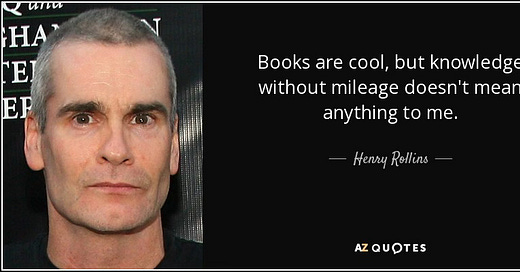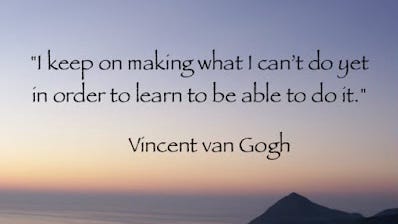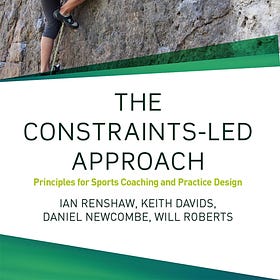In the prologue for this series, I wrote about the value of a coaching philosophy. In this part, I will write about one way that my own coaching philosophy emerged. I encourage you to read the prologue to understand the basis I use for considering learning and sources of knowledge.
This part of the series comes from when I first read Gallwey’s The Inner Game of Tennis. I wrote about the book in 2018 and you can read it here:
But what you’ll read below is not about Gallwey’s book but about how that book led me to open up my thinking about how to learn as well as how to teach.
I first read W. Timothy Gallwey’s book, The Inner Game of Tennis in the mid-2000’s, after I had already been coaching for 10-15 years. I had been both an assistant coach and a head coach of several club volleyball teams, as well as a collegiate assistant coach by then. I knew quite a bit about coaching at that point but far less than what I have learned since then. I had read some classic books in the volleyball coaching canon and had observed some famous coaches during their practices. I knew I didn’t have it all figured out but I thought I had at least figured out how to teach and learn. Turns out I was wrong.
Okay, maybe that’s a bit dramatic. I was actually a half-way decent club coach. I knew plenty of drills and games and I could establish and maintain a decent rapport with players and parents I worked with. It’s not that I couldn’t coach but that period opened me up to a lot of lessons that would make me a better teacher, learner, and person. During that time in my career, the most impactful lessons for me were what I learned from reading Gallwey’s book as well as what I learned about myself.
If you read the book, you’ll notice that Gallwey’s style is to tell stories. He recounts tale after tale of “I used to do x, but then I noticed something interesting so I tried doing y instead.” He uses these stories to slowly build a framework of how he believes tennis should be taught and learned. It would be a stretch to call the book a how-to manual, but that’s basically what I got out of it, how to work with athletes in a very different way. Gallwey had written much more than a series of steps to follow but I distilled it down to that anyway. But, in my defense, Gallwey also didn’t clearly point out if there was more I should have gotten out of it.
For me at that time, there were two things I could take away from reading the book, I could remember the stories he told or I could remember how to coach like he coached. Of those two options, I only saw value in remembering the how-to. Because of how I perceived learning, I couldn’t see how much more was actually there for me. What I had failed to see when I first read The Inner Game of Tennis was how Gallwey’s learning journey had unfolded. As I said before, he didn’t write a how-to manual. He told stories of trial and error and of discovery. I now see that these are the things that I could have, and very slowly did, eventually learn from him.
Trial and Error
The way I treated Gallwey’s book, turning it into a how-to manual, showed that I was treating knowledge as something I could, or should, acquire. I should read books, watch better coaches, and take notes. If I did, then I would learn the lessons they had to offer. Once I had done that, then their knowledge would also be my knowledge and I could do what they did. This approach to learning put me pretty far towards the naïve end of Grecic and Collins’ learning philosophy spectrum. (Go back and read the prologue of this series to refresh your memory.)
A hallmark of the naïve view is a belief that if I apply knowledge I have acquired from a respectable authority, it should just work. This position is adopted by many coaches, they accept what they read and see successful coaches doing as facts that hold true everywhere. When I started using Gallwey’s techniques for skill instruction and feedback, they worked, which is an expected outcome when you hold that view of knowledge. I expected Gallwey’s stuff to function for me because that stuff had functioned for him. But I failed to notice that there was actually more going on than just replicating what I saw or read. I had yet to learn from Gallwey’s stories of trial and error. I had yet to learn a lesson from Henry Rollins.
Why did Gallwey tell stories of trial and error? Because he wasn’t doing things exactly the same all the time. He was taking feedback from what he tried and making changes. He was tailoring his teaching to work better for himself and for the learners. The more teaching he did, the more he tweaked his methods. As time went by, I wasn’t doing exactly what Gallwey did anymore, I was subtly changing it to better suit me and my circumstances. We were both, to paraphrase Rollins, putting some mileage on our knowledge.
Had I continued to be locked into the naïve view of learning and knowing, I would have done only what Gallwey wrote about or what I had seen others do. But doing only what he/they had done is knowledge without mileage. It doesn’t mean anything because there’s no more learning going on. The problem wasn’t with Gallwey’s knowledge because he had put in the miles to figure it out for himself and to make the knowledge work well for him. The problem was with me importing his knowledge without recognizing that I needed to put in my own miles and not just accept his. I assumed that because his ideas worked for him, they would work for me, without much thought or effort, in a completely different time, place, and situation. Putting in the miles means making changes as the coach, the players, and the situations change.
The beginning of putting in the miles is saying things like, “I bet this would work better if I did it a little differently.” Thoughts like those come when you see little gaps or inefficiencies between the way you read or saw something and the way it actually happens when you try it. The crucial difference is what you mean by “better”. Does “better” mean that it conforms more closely to how you read it or saw it? Or does “better” move in an original direction? Conforming means no mileage, originality means mileage. Forcing yourself into a new space, even just a little bit at a time, earns you more mileage and more learning. As I applied Gallwey’s ideas to my own coaching, I explored on the edges, trying some relatively safe variations on Gallwey’s ideas that seemed to make more sense in my situations or that felt more comfortable for me personally. Rather than force athletes or situations to change, I adapted the ideas I held and I adapted myself. I slowly integrated some mildly different ideas into who I was and, as a result, slowly became someone different than I used to be and someone who did things a little differently than Gallwey. The more little changes I made, the better my coaching became and the more comfortable I became making more and bigger changes. This willingness to make changes brings us to the second kind of story Gallwey liked to tell.

Discovery
Making changes to existing knowledge may not seem like much, but it reflects a different way of viewing knowledge. Instead of something fixed and constant, knowledge becomes something malleable and constructable. When Gallwey told stories of discovery, he was also telling stories of creation. He was figuring things out for himself. He had been a tennis pro and teacher for some time already and, rather than look outward to other pros for new ideas to copy, he looked inward and broke new ground. Instead of looking to acquire knowledge from outside sources, he created his own knowledge. This is a significant move away from the naïve view of learning.
As I gradually moved away from a strict interpretation of Gallwey’s ideas, I also moved away from a naïve view of learning. This move means that I believed, whether I was conscious of it or not, in my ability to generate knowledge. When I say that you can create knowledge, I am not saying that you can’t acquire knowledge or that trying out someone else’s ideas won’t work, but I am making a subtle distinction. I’m saying that learning isn’t contained in a book nor is reading that book a learning process. Learning, I believe, is changing your behavior. Learning is taking an idea and putting miles on it. Learning is also discovering a new idea when you’re immersed in your unique context. Learning is in the doing.
There’s one last important thing to know about creating knowledge. That activity isn’t restricted to only certain kinds of people. We can all do it. There’s no special license you need to try original things, no one is going to tell you that you can or can’t do it except you. There’s only two things you need to try. The first is knowledge of your specific situation. That knowledge is something that gives you insights that all the coaches you read and watch may not have. What have you learned about the players in your care? You’re the only one who knows them like you do so use that knowledge to make your coaching better! What have you learned about yourself? The things you notice about what works and what doesn’t work is unique to you, the players, and the situations you’re all in together. Those things you notice are the inspiration for your ideas of what might work better. The second thing you need is a little bravery to try the idea you think of. Is there a little more risk in trying an idea that you thought of instead of something that a famous coach thought of? Maybe. Try it anyways. See if it works and how well it works. Learn from the experience and try again.
This is what “knowledge with mileage” looks like. What I learned from this period in my coaching career is that I was able to develop my own knowledge along with acquiring knowledge from others. This shift in beliefs about where knowledge comes from was a change in my learning philosophy. And yet, it was not an epiphany. I didn’t know at the time that I was changing my beliefs, but I knew that my coaching was growing more comfortable and making more sense. When I look back at how Gallwey wrote Inner Game, I see now that he was doing the same thing I was doing. He was trying his own ideas, sometimes more successfully than other times. He was generating knowledge and putting mileage on it to see what happened.
To develop your coaching philosophy, I encourage you to do on purpose what I did by accident. Start by questioning where your knowledge comes from. Does everything you do come from someone else? Is that how you want it to be? If it is, then do it. Recognize that is your learning philosophy and get busy living it as well as you can. Find sources of knowledge that most closely resemble the world that you coach in. Get what you can from them and replicate what you find as well as you can. Do you want to create some knowledge yourself? Do it. Recognize that you are a valid source of knowledge, no matter who and where you are. The more you try and reflect on what you tried, the more easily it will come to you. I don’t think one learning philosophy is necessarily or always better than another, I think there’s the one that allows you to do your most authentic coaching.
In the next part, I’ll use my experiences around two more books to dive into how developing a philosophy can continue (or stall).









What a great write up and something I've been reflecting on in my coaching career.
I coach club volleyball in Canada and I never played the sport growing up. I got into coaching because the club my daughter was in needed help so I stuck around the gym and became a helping hand. When my daughter attended camps, I would listen to the head coach and try out the techniques he or she was teaching to get a better understanding in how the core skills work of passing, setting, hitting, serving. I was the dad with the tripod recording all of my daughter's games in club and high school and then I'd watch them and I'd query my daughter on what was happening during such and such play and what would be a better way. Then I started watch matches on youtube, NCAA, FIVB, high school matches to get a better understanding of how the game flows. Then it branched to reading books, watching videos, reading the actual rules of the game and then I volunteered to become an assistant coach.
After 4 years of assistant coaching and my daughter aging out of the club scene, I became a head coach and started first creating practice plans from the coaches who have mentored me, to discovering other ways of organizing, devising and implementing practices and teaching the game. What is interesting was while I was on my coaching journey, I would hear about Galloway's book talked about. And when I finally picked up my copy and read through it, I have to admit, it was a bit esoteric for me. I was stumbling along the how-to parts of it and I think things clicked into Trial and Error then Discovery when a Drill I was watching a video on which I put into my practice plan, was not working as intended in practice...
I said out loud "Wow, the movie that's playing in my brain is not playing out to what I directed on the court" and my assistant was laughing at me. She told me, I should just call out "end scene" and reset myself and get the drill to work in a way that will work for the athletes.
I believe that's when it clicked for me and what makes coaching so rewarding. It's the discovery of learning and teaching, even when I'm at times full of a lot of self-doubt.
The good thing for me is, the athletes continue to come back and enjoy the practices. I've had many athletes tell me they enjoy the practices and learning and refining their skills and learning to work with their friends.